Microwave anneal of a thin lamina for use in a photovoltaic cell
a technology of photovoltaic cells and thin semiconductor laminas, which is applied in the field of microwave energy to anneal thin semiconductor laminas for use in photovoltaic cells, can solve problems such as difficulties in thermal anneal
- Summary
- Abstract
- Description
- Claims
- Application Information
AI Technical Summary
Benefits of technology
Problems solved by technology
Method used
Image
Examples
example
Activate Dopants
[0058]Other embodiments may include a shallow junction formed at the cleaved surface, as described by Hilali et al., U.S. patent application Ser. No. 12 / 399,065, “Photovoltaic Cell Comprising an MIS-Type Tunnel Diode,” filed Mar. 6, 2009, owned by the assignee of the present application and hereby incorporated by reference.
[0059]Such a shallow junction can be formed using a microwave anneal. Referring to FIG. 7, following formation of lamina 40 affixed to receiver element 60 (interposed layers, if any, are not shown), and treatment of second surface 62 to remove surface damage, a spin-on or spray-on dopant can be formed on second surface 62, including an n-type or p-type dopant, or a dopant may be provided by shallow ion implantation. A microwave anneal drives the dopant into second surface 62 of lamina 40 and activates it, forming shallow doped region 16. Fabrication continues to form a photovoltaic cell, as described by Hilali et al.
PUM
 Login to View More
Login to View More Abstract
Description
Claims
Application Information
 Login to View More
Login to View More - R&D
- Intellectual Property
- Life Sciences
- Materials
- Tech Scout
- Unparalleled Data Quality
- Higher Quality Content
- 60% Fewer Hallucinations
Browse by: Latest US Patents, China's latest patents, Technical Efficacy Thesaurus, Application Domain, Technology Topic, Popular Technical Reports.
© 2025 PatSnap. All rights reserved.Legal|Privacy policy|Modern Slavery Act Transparency Statement|Sitemap|About US| Contact US: help@patsnap.com



